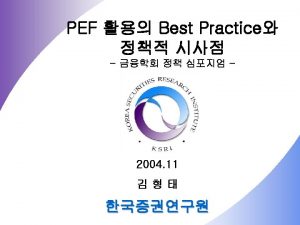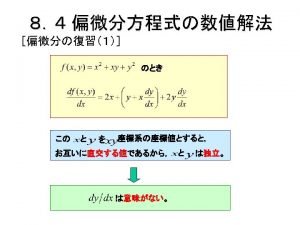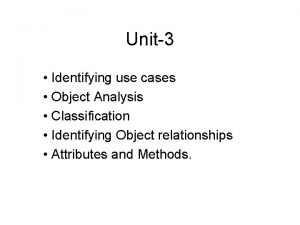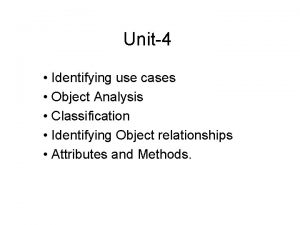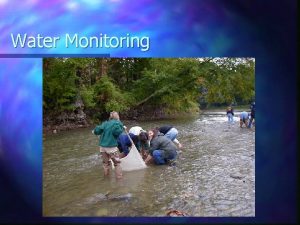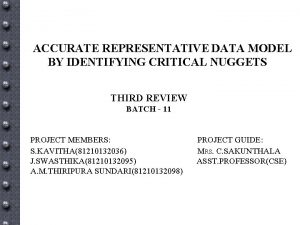Identifying Private Water Use for Accurate Water Planning





















- Slides: 21

Identifying Private Water Use for Accurate Water Planning Models Andrew Pappas, MPH Project Manager Public Health Drinking Water Environmental Public Health Division June 26, 2018 For Official Use Only – Not For Distribution Preliminary Information – Subject to Revision

Introduction to Water in Indiana - Approximate 30% of Hoosiers using unregulated water source - Nearly 2 million individuals Well water Surface water Cisterns, etc. - Well - Surface - Spring Cistern - Private Water Supplies Composed of Groundwater, Surface Water - Dug Driven, Sand Point Bored Drilled - Pond River - Regulation Largely Focused on Drilled Wells after 1968, Septic Siting

Sanitary Engineering – Drinking Water History of Public Health and Water • • This year is Indiana's Bicentennial celebrating statehood - December 11, 1816 First local ordinance for well water passed in 1814 [use, ‘bucket laws’] A national day of prayer, fasting for ‘public health’ – Proclaimed November 1832 Formation of the State Board of Health – 1881, local boards date back to 1830 s Early reporting of water impacting health in the late 1870’s – cholera, typhoid Indiana State Laboratory began testing water quality in 1906 Man-made contamination recognized by General Assembly as water hazard 1913

Water Source Data Locations of Water Wells, Indiana Geologic Survey IDNR

Water Testing and Quality - Water supplies for a relatively large portion of well locations go without testing for common contaminants such as: - Arsenic Bacteriology Fluoride Nitrates/Nitrites Lead and Copper - 2 of 92 require on property transfer 1 of 92 require on new drill State DNR requires DRILLER to qualify water as free and clear - Heaviest reliance on private water supplies Most likely to be maintain private water well 190, 000 estimated exposed > MCL, 900, 000 detecable - Few counties maintain ordinances that require testing - Known arsenic availability in soils across most water accessible regions

Groundwater Quality in Indiana • With certain exceptions, most groundwater samples from the Indiana Groundwater Monitoring Network, part of the Indiana Department of Environmental Management, did not have notable contamination • 86% of all samples did not contain above a U. S. Environmental Protection Agency (U. S. EPA) Maximum Contamination Level (MCL) • Arsenic and Nitrates were the only contaminants above the MCL with one exception

Arsenic • Arsenic found above the detection limit of 1 µg/L in 530 of the samples (45%). • Exceeds the MCL of 10 µg/L in 139 samples (11%). • Highest concentration so Arsenic observed in glacially derived settings

Nitrogen, Nitrate-Nitrite Results • Mean Nitrate concentrations generally higher in: • Sensitive areas • Wells screened in unconsolidated materials • Wells screened les than 50 feet deep

Types of Ordinances - Property Transfer - La Porte, St. Joseph Requires water testing upon property sale, transfer Water must be sampled for nitrates and bacteria, e. coli Arsenic also at SJCHD – requires treatment in place for sale of home Filed with the county health department, unknown data storage - May have different separation distances, depths Outright ban inside of municipal boundaries, remove competition with municipal water supplies - Additional licensure to work in a county Fee to file permit to drill well, repair equipment Sanitization paperwork to be filed upon completion - Marshall County New water wells are required to be tested for Bacteria, Nitrates, and Arsenic Does not require treatment, only meant to inform - Location Siting - Drilling and Pump Installation - Drinking Water Quality

Mapping Water Rules in Indiana • Most local rules for well waters related to engineering, design, and location • Few require testing outside of coliforms at well completion • Property transfer laws provide a wealth of information, allow for ad hoc groundwater monitoring • Other states have robust programs requiring health protective testing for private water use

Water Well Location Data • IDNR has 407, 485 water well logs digitized and online with construction details (note: record entry up to 1 year behind submission) Location Type County Centroid Estimated Location/Geocoding addresses Estimated Location/TRS_quarter sections_county Field Located Office Located/Geocoded Count 2237 15, 257 203, 732 146, 896 39, 363 • In 1906 Indiana has an estimated 351, 000 wells servicing 1, 757, 000 people • ~ 1 well to 5 people • In 2017 Indiana has 407, 485 documented wells serving an unknown population

Basic Approach County Name La. Grange Whitley White Steuben Kosciusko Carroll Warren Fulton Marshall Pulaski Noble Parke Miami Tipton Well Count Households 9547 11, 598 6777 9, 228 4772 6, 849 8691 13, 310 18355 29, 197 4606 7, 900 1857 3, 337 4071 8, 237 8431 17, 406 2352 5, 282 7565 17, 355 2617 6, 222 5548 13, 456 2537 6, 376 % Households on Wells 82 73 70 65 63 58 56 49 48 45 44 42 41 40 Does not account for plugged wells or wells drilled without logs Household data from 2010 Census; wells current to Dec. 2016

Introducing External Data Sets • SBA Data • Parcel ID • Water (Y) • AV Dwelling • IDNR Data • Address of Well • GPS Point of Well • IURC Data • 2014 Water Area Boundaries • GIO Data • Aerial Imagery • Parcel Boundaries • Other data as required

Challenges with Data • Not all ‘standardized’ data is reliable • Relying on outside agencies to insure data quality, integrity • Elected officials vary, administrations focus on records vary • Incomplete data is difficult to identify, nearly impossible to verify incorrect data • Changes and updates to External Data anticipated • Before the data is made useful, it is outdated • Completing the analysis takes a lot of data, a lot of time to re-run • Storage is not free • Using the data in other applications requires us to host multiple GBs of data, which is currently not feasible based on budgets • Inability to host the data for others requires PM to manage data requests

Benefits of the Information • Rapid response time for questions related to private water supply locations, characteristics or population • Used for emergency response to natural disasters, environmental pollution discharges, outreach program planning • Provided data to CDC, EPA, ATSDR, State and County agencies • Clear understanding of populations at risk, prioritize sites • Recently used for arsenic testing near oil and gas wells, heavy metals near coal combustion residual impoundments, volatile organics compounds near industrial sites • Provide input in State Water Budget planning • Accurately provide population information about demographics • Improve holistic approach to long-term water funding, initaitves

Practical Use • Of 2, 222, 719 parcel records with a dwelling on the site, 856, 181 have been denoted by county assessors as not having municipal water • Accuracy inside of regulated water service boundaries is suspect • Increased resolution with better data


Private Water Location Data Location Type Parcel Dwelling Record ‘Yes’ Public Water Parcel Dwelling Record ‘No’ Public Water Parcel Dwelling Record - Accurate Well Log Match ---Water Well Log within Water Service Area, Denoted Public Water Total Parcel Records with Dwellings Count 1, 366, 538 856, 181 84, 789 43, 914 15, 348 2, 222, 719 • Based on parcel records alone, 38% of Indiana homes do not have water supplied by a municipal source • Only 10% of the homes with No public water supply have an accurate water well log on file • Nearly 1% of the records from across the state have, in theory, both a private water well and public water supply

Limitations • Assessor records vary, inaccurate • Missing information on well depth, well type not able to be interpreted • Large data set makes sharing a challenge • Various source data owners update schedules vary, non-existent

Conclusion • Datasets from outside agencies have been used to improve program response to: • • • Emergency Management activities Public Health education planning Testing needs based on local contamination Future water infrastructure planning Improve spatial resolution for future modeling • Local Health Departments • Support investigations, outbreaks • Provide true ‘well water burden’

Contact Information Andrew Pappas, MPH Project Manager (317) 233 -7360 apappas@isdh. in. gov Connect on Linked. In Please contact author for any citation requests Not for citation or distribution
 Identifying and non identifying adjective clauses
Identifying and non identifying adjective clauses Non identifying adjective clauses examples
Non identifying adjective clauses examples Identify the essential
Identify the essential Water and water and water water
Water and water and water water Use case analysis
Use case analysis Kontinuitetshantering i praktiken
Kontinuitetshantering i praktiken Novell typiska drag
Novell typiska drag Tack för att ni lyssnade bild
Tack för att ni lyssnade bild Ekologiskt fotavtryck
Ekologiskt fotavtryck Varför kallas perioden 1918-1939 för mellankrigstiden?
Varför kallas perioden 1918-1939 för mellankrigstiden? En lathund för arbete med kontinuitetshantering
En lathund för arbete med kontinuitetshantering Särskild löneskatt för pensionskostnader
Särskild löneskatt för pensionskostnader Tidbok
Tidbok A gastrica
A gastrica Vad är densitet
Vad är densitet Datorkunskap för nybörjare
Datorkunskap för nybörjare Boverket ka
Boverket ka Tes debattartikel
Tes debattartikel Delegerande ledarskap
Delegerande ledarskap Nyckelkompetenser för livslångt lärande
Nyckelkompetenser för livslångt lärande Påbyggnader för flakfordon
Påbyggnader för flakfordon Arkimedes princip formel
Arkimedes princip formel




























